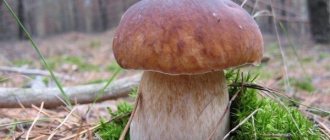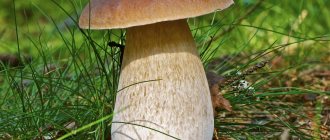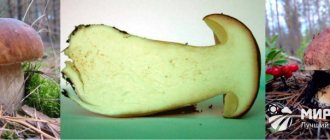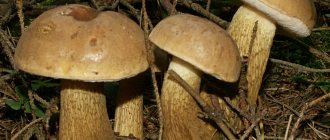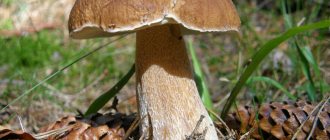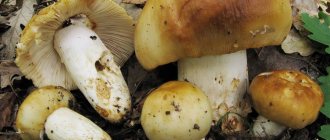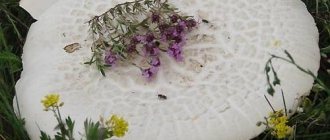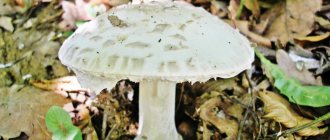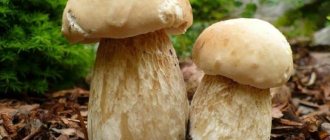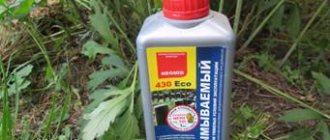The reticulated boletus is an inveterate inhabitant of forests. The mushroom belongs to the Boletaceae family, the boletus genus.
Without a doubt, it can be cut and placed in a basket, since it is edible. Very often, mushroom pickers consider the reticulated boletus to be a variety of porcini mushroom. But this is a separate species with excellent properties.
It appears mainly in the summer, which is why it has earned the name “White Summer Mushroom”. It grows mainly in oak groves and deciduous forests.
How not to confuse boletus reticulum with other types of mushrooms? What are its main features?
Description of white mushroom
The cap of a mature porcini mushroom reaches a diameter of 7-30 cm (sometimes up to 50 cm), convex, in old mushrooms it is flat-convex, rarely spread out.
The surface is smooth or wrinkled, may crack in dry weather, bare, may be thin-felt (especially at the edge), rarely fibrous-scaly. In wet weather the surface is slightly slimy, in dry weather it is matte or shiny. The color of the skin is from red-brown to almost white, darkens with age, it can also be lemon-yellow, orange, purple tones, often the color is uneven, with light edges, sometimes with a narrow pure white or yellowish rim. The skin is adherent and does not separate from the pulp.
The pulp is strong, juicy-fleshy, fibrous in older specimens, white in young mushrooms, turns yellow with age, does not change color after cutting (a slight change in color to pink or blue is extremely rare), under the dark-colored skin there may be a layer of brown or red-brown shade. The taste is mild, weakly expressed, the smell of raw pulp is faintly distinguishable, a strong pleasant mushroom smell appears during cooking and especially during drying.
The leg is 8-25 cm tall (usually up to 12) and up to 7 cm thick (rarely 10 or more), massive, barrel-shaped or club-shaped, elongates with age and can become cylindrical, widened or narrowed in the middle, the base often remains thickened. The surface is whitish, brownish, sometimes reddish, and may have the same shade as the cap, but lighter. Covered with a mesh of white or lighter veins. The mesh is usually in the upper part of the leg, but it can also go down to the base; much less often it is absent or weakly expressed.
The tubular layer with a deep notch near the stem, easily separates from the cap flesh, is light, white in young mushrooms, later turns yellow, then acquires an olive-green color, very rarely with a pinkish-red tint at a young age. The tubes are 1-4 cm long, the pores are small and round.
There are no remains of the bedspread.
Spore powder is olive-brown. The spores are spindle-shaped, the average size is 15.5 × 5.5 µm, the sizes can vary quite greatly even in the same sample (11-17 × 4-5.5 µm), occasionally they are very elongated, up to 22 µm, but their width does not exceed normal.
Cystids are found in large numbers in young mushrooms, mainly on the surface of the hymenophore (cheilocystids), standing in a palisade, forming a felt-like layer, which determines the white color of the young porous surface. After the pores open, the cystids are concentrated along the edges of the tubes. There are also cystids on the threads of the reticulate pattern of the stalk (caulocystids) and on the surface of the cap (pyleocystids).
Varieties
Boletus mushrooms grow everywhere in the forests of Russia, and there are a great variety of them. It is clear that they are all from the same family. They are distinguished only by the nuances of their appearance. All belong to the first taste category, each has an inedible double. Therefore, when starting a “silent hunt”, carefully study the external signs of those mushrooms that are found in your area.
Pine
Its external characteristics practically repeat the general description of boletus mushrooms. What are the differences:
- The cap is red-brown with a diameter of 8-25 cm. Shade – purple.
- Pulp. Under the skin it is pink.
- The leg is very thick, short - up to 15 cm. On top there is a light brown mesh.
- The thickness of the tubular body is 2 cm. The shade is yellowish.
It has an early form, characterized by a lighter cap and flesh. Growth begins at the end of spring and continues until October. It settles under pine trees - hence the name. With them it forms mycorrhiza - a fungal root. Found on sandstones, alone and in families. Distribution area: Europe, America, the European part of Russia.
Birch
Its second name is spikelet. It is collected when earing of rye fields begins. Distinctive features:
- The hat is light yellow, with a diameter of 5-15 cm. The flesh does not have a distinct taste. It does not darken at the break.
- The leg is barrel-shaped, with a light mesh.
- The thickness of the tubular layer is 2.5 cm. The shade is yellowish.
Prefers to grow under birch trees. They grow singly and in groups. Favorite places are on the edges, near roads. Distribution area: Western Europe, Siberia, Far East. Collection season is June-October.
Dark bronze
Hornbeam or copper. Species differences:
- Round, fleshy cap with a diameter of 7-17 cm. Dark shades. It may be covered with cracks.
- The pulp is white. With a pleasant aroma and taste. In the rift the color changes.
- It is distinguished by a massive leg - it is pinkish-brown. Covered with brown mesh.
- A tubular layer 2 cm thick. Yellow in color, turns green when pressed.
Grows in deciduous forests in warm climates. Distribution: Europe, North America.
Other varieties
There are also the following varieties of porcini mushroom:
- Reticulate.
It has a brownish or light ocher cap. The leg is short, cylindrical in shape. Can be confused with moss fly. Prefers beeches and hornbeams. Grows in Europe, North Africa and North America. It has a pronounced mesh on the leg. Fruiting time is June-September. Rarely seen. - Oak.
The hat is grayish in color. Sometimes there are light spots on it. It differs from other boletus mushrooms in its more loose pulp. Prefers oak groves. Habitat: Caucasus, Primorsky Territory. It has a brown cap, very similar to the gall mushroom. - Semi-white mushroom.
The color of the cap is light brown or clayey. The flesh is dense and smells like carbolic acid. Distribution area: Carpathian region, Polesie, southern Russia. There is no mesh pattern on the leg. The hat is light brown.
White mushroom reticulate
White oak mushroom
Semi-white type of porcini mushroom
Habitat
Oak porcini mushroom - although a widespread species, is not as common as other varieties of porcini mushroom. It grows in temperate climate zones, but gravitates to the south. Most often the habitat regions are mountainous or hilly areas.
The white oak mushroom has become widespread in North America, Eurasia, and North Africa. In the CIS - these are the temperate climate regions of the European part, as well as Crimea, Krasnodar Territory, Transcaucasia, etc.
Prefers dry alkaline soils. Grows in small groups or singly.
Where does the porcini mushroom grow?
This species forms mycorrhiza (symbiosis with the roots of the plant) with deciduous trees: oak, beech, hornbeam, linden, edible chestnut.
Many, especially beginners, mushroom pickers are interested in where to collect white oak mushroom. The mushroom grows in light deciduous and broad-leaved, less often mixed forests.
Information! The white oak mushroom grows on the roots of oak, beech, hornbeam, linden, and edible chestnut.
Varieties
The types of porcini mushrooms differ not only in appearance, but also in the characteristics of their symbiosis with the roots of higher plants. They are found on soils with different compositions and in regions with different climatic conditions.
White mushroom reticulate
This species prefers to grow on dry alkaline soils and bears fruit from June to September. Often found in chestnut, beech and oak forests in Europe, America and Africa. The reticulated appearance has an external resemblance to the flywheel.
Distinctive features:
- the leg is short, has a cylindrical shape and a mesh pattern of a light brown shade;
- The cap is ocher or brownish, its diameter can reach 30 cm.
An old mushroom may have small cracks on the cap.
White mushroom dark bronze
It has other names - copper and hornbeam. Found in deciduous forests of warm climate zones.
External description:
- the cap is dense, has a dark, rich color (in young mushrooms it is almost black) and a convex shape;
- the diameter of the cap is up to 17 cm, there may be cracks on the smooth peel;
- The pinkish-brown leg is cylindrical in shape, thickening at the bottom.
The tubular layer (hymenophore) of young mushrooms is almost white; later it can become light yellow. When pressed, a greenish tint appears. The species bears fruit from July to October; in some regions it can be found from May.
White birch mushroom
It grows under birch trees, the fruiting period lasts from early summer to October. It appears in the forest when the ears of grain crops are ripening, therefore it is also called the spikelet.
External differences:
- the light-colored cap has a diameter of up to 15 cm;
- yellow hymenophore;
- The white leg is shaped like a barrel and has a light brown pattern on it.
When cut, the pulp does not have a strong aroma.
White pine mushroom
This type is found on sandy soils. It bears fruit most often near pine trees, in rare cases it can grow under spruce and deciduous trees. Found in pine forests of Europe, Asia and America.
Distinctive features:
- the diameter of the pillow-shaped cap can reach 25 cm;
- the surface of the cap is red-brown with a purple tint, with a light edging along the edges;
- the tubular layer has a yellowish color;
- the thick leg is very thickened towards the base, covered with a cream-colored pattern.
Fruits from early summer to September, and can occur from late spring.
White oak mushroom
A distinctive feature of the oak species is the brown color of the cap with a grayish tint. Other features:
- loose pulp;
- there may be light spots on the cap;
- grows in large groups.
Found from early summer to mid-autumn. Habitat: oak forests of the European part of Russia, Primorsky Krai, and the Caucasus.
Spruce porcini mushroom
The most common variety, found in fir and spruce forests on various continents except Iceland and Australia. It can also bear fruit under deciduous trees. The fruiting period is from June to October.
External characteristics:
- the cap has a convex shape, brown or chestnut hue (diameter - up to 30 cm);
- the peel is velvety to the touch and does not separate easily;
- the hymenophore has a light yellow color;
- the leg is light brown, thickened at the bottom.
The development of the spruce species is favorably influenced by warm nights, fogs, thunderstorms, as well as the presence of sandy soil and loam. The spruce mushroom often prefers open areas that are well warmed by the sun's rays. Grows in old forests with an abundance of moss and lichens.
Other varieties
Another variety is the royal mushroom (royal), found on soils with an abundance of limestone and sand. This is a tasty and aromatic species; its distinctive features are a bright, expressive cap and a yellowish stem. When broken, the pulp of the royal boletus acquires a bluish tint.
There is a rare species - a semi-white mushroom, more often found in the Carpathian region and the southern regions of Russia. Its cap has a clay-brown tint; when cut, the pulp emits a specific odor of iodine. According to its taste characteristics, the semi-white mushroom is classified into category 3.
When and where does it grow?
The distribution range of boletus mushrooms is amazing - they are found on almost all continents. The exceptions are Antarctica and Australia. Japan, Mexico, Mongolia, North Africa, the Caucasus - boletus grows everywhere. You won't find it except in Iceland. In Russia it grows almost everywhere - from the southern latitudes to Kamchatka. The spruce boletus is found in spruce and fir forests.
Each area has its own fruiting time. In warm zones, the mushroom begins to grow in May-June, and bears fruit until October-November. In the north, the growth period is from June to September. It has a long growth phase - it needs to grow for a whole week to reach maturity. Grows in families, rings. Having discovered one specimen, you need to carefully explore the nearby space - there will probably be several more there.
Prefers to grow in forests:
- conifers;
- deciduous;
- mixed.
It grows most often under spruce, fir, pine, oak and birch trees. Where to look for them:
- in places overgrown with lichen and moss;
- loves old forests;
- It can grow in the shade, but the sun doesn’t bother it either – it prefers warm areas.
It doesn't grow:
- in wetlands;
- in peat bogs.
Rarely found in forest-tundra and steppe. His favorite soils:
- sandy;
- sandy loam;
- loamy.
Mushroom pickers tell how to find boletus mushrooms in forest-steppe conditions. They will reveal to you the secrets of mass collection, and where porcini mushrooms are hidden:
Harm and contraindications
The boletus mushrooms need to be chewed well, because they are already difficult to digest in the stomach. They should be consumed in moderation. The digestive system of young children is too vulnerable and is not able to cope with heavy foods, so it is not recommended to include mushrooms in their diet. It is better to gradually introduce them into the children's menu after 10 years.
Even an edible mushroom can pose some danger to human health. After all, this product has a high degree of sorption; it can absorb toxic substances, as well as salts of heavy metals. Therefore, it is not recommended to buy oak porcini mushrooms from private traders, because they could have been collected near highways or industrial facilities. By following all the recommendations, you can enjoy delicious and healthy mushrooms all year round without harm to your health.
How to store
Porcini oak mushroom is considered by experts to be one of the most delicious mushrooms. The taste is reminiscent of spruce porcini mushroom, but has a more refined aroma. In its raw form, the taste and aroma are weakly expressed and are revealed during cooking.
Oak porcini mushroom is universal and has shown itself to be excellent in any type of preparation. It is also widely used in canning, both as a mono component and as part of vegetable stews.
The advantages of this type include the fact that with any type of culinary processing, including drying, it retains the original color of the pulp - white, and looks beautiful and appetizing.
The mushroom is especially fragrant when dried. At the same time, this method of harvesting is quite simple and not troublesome and allows you to extend the shelf life of white oak mushroom. There is no need to pre-wash the mushrooms, just clean them properly. The prepared fruiting bodies are strung on a thread and dried in the open air. An oven, oven or electric dryer is also used for these purposes.
Overdried, broken specimens are ground into powder in any convenient way, and then used as an aromatic seasoning in the preparation of soups, sauces, and main courses.
Information! The protein contained in oak porcini mushrooms is most fully absorbed by the body (up to 80%) when consumed in dried form.
Freezing is also a fairly quick and economical way to prepare porcini mushrooms for the winter. The result is a semi-finished product that is immediately ready for basic culinary processing.
Information! Both dried and frozen, the nutritional value of oak porcini mushroom is completely preserved.
Preliminary preparation of mushrooms intended for freezing and drying is similar. An important distinguishing point is that they cannot be washed. Since the pulp of white oak mushrooms absorbs water well, after freezing and subsequent thawing, the mushrooms will become unsuitable for food. Therefore, washing is replaced by wiping the surface of each fruiting body with a damp cloth.
Important! It is unacceptable to wash oak porcini mushrooms intended for drying and freezing.
And, of course, the high taste qualities of oak porcini mushroom are perfectly revealed when salted and pickled. Young specimens are selected for these preparations.
Types of porcini mushroom
White birch mushroom (Boletus form betulicolus) or Boletus edulis form betulicola. It is distinguished by its light to almost white cap color and its growth under birch trees.
Spruce porcini mushroom (Boletus edulis form edulis). The edge of the cap is leathery and sharp. The cap is convex on top and brown in color. The tubular surface is light yellow or olive yellow. The length of the tube is 1-4 cm. The leg is dense, club-shaped, and has a mesh pattern in the lower part. The pulp is dense, white, does not change color when cut, and has a pleasant smell.
White pine mushroom (Boletus form pinophilus), or pine variety (Boletus edulis form pinicola). This form has a large dark cap, sometimes with a purple tint. The flesh under the skin is brownish-red.
Dark bronze white mushroom, or hornbeam (Boletus aereus or Boletus edulis form aereus). A very dark-colored mushroom, almost black, grows in beech and oak forests. It is found in Europe, in more western and southern regions (from Spain to Western Ukraine) and in the USA.
White mushroom (Boletus reticulatus) or Boletus edulis form reticulatus. This form has a light-colored brownish or ocher cap and a short cylindrical stem, resembling a moss fly in appearance. Grows with beech and hornbeam in Europe, Transcaucasia, North America and North Africa. Occurs in June - September, not often and not abundantly.
White oak mushroom (Boletus edulis form quercicola). The oak form of the porcini mushroom is more heat-loving and is found en masse in summer in broad-leaved oak forests. The color of the cap is grayish-brown with whitish spots, the stem is quite long, thickened towards the base, the same color as the cap with a weak mesh along the entire length of the stem. In oak forests, a bronze form also grows with a finely wrinkled bronze-brown cap with a darker top, with a gray-fawn stem and an inconspicuous mesh pattern along almost the entire thin stem.
Description of boletus reticulum
The diameter of the cap of the white oak mushroom is 8-25 centimeters, but in large specimens it can reach 30 centimeters. The cap is covered with a slightly velvety skin. In dry weather, the caps crack and sometimes a characteristic mesh pattern appears. The color of the caps is very variable: brownish, coffee, gray-brown, ocher, sometimes there may be whitish spots.
The tubes are thin and loose. The edges of the tubes in young specimens are white, then yellow-green or olive green. The spores are honey-yellow or brown. Olive-brown spore powder.
The length of the leg of the reticulated boletus is 10-25 centimeters, and its diameter ranges from 2 to 7 centimeters. At first its shape is cylindrical, but with age it most often becomes club-shaped. The light walnut leg is covered along its entire length with a pronounced brownish or white mesh.
The flesh of these mushrooms is dense, but as it ages it becomes a little spongy, especially when it comes to the stem. If you press on the leg, it seems to spring back. The color of the pulp is white and does not change in air. Under the tubular layer, the flesh may be yellowish. The aroma of the pulp is pleasant, mushroom, and the taste is sweetish.
Distribution of white oak mushrooms
White oak mushrooms are one of the earliest species; they can be found as early as May. And they continue to bear fruit until October.
They grow in deciduous forests, most often found under beeches, oaks, lindens, hornbeams and edible chestnuts. These mushrooms prefer warm climates. They are generally found in hilly and mountainous areas.
Similarities between boletus reticulum and other mushrooms
The netted boletus can be confused with other types of porcini mushroom, for example, the white pine mushroom also has a stalk with a net, but it is only present in its upper part.
Beginners may confuse the reticulated boletus with a gall mushroom, but it can be recognized by its black mesh and pinkish hymenophore; in addition, gall mushrooms grow in coniferous forests.
Evaluation of taste qualities and beneficial properties of white oak mushroom
Boletus reticulum is considered one of the best mushrooms. When dried, it is very aromatic. These mushrooms can be pickled and consumed fresh.
White oak mushrooms have long been famous for their healing properties; tuberculosis and ulcers were treated with their help in Rus'. Reticulated boletus contains hercinin, which has a beneficial effect on the functioning of the heart. There is evidence that reticulated boletus mushrooms have an anti-carcinogenic effect. These mushrooms are useful to eat raw in a variety of salads.
Other mushrooms of this genus
Fechtner's boletus grows in deciduous forests on calcareous soil. These mushrooms grow in the Far East and the Caucasus. They bear fruit from June to September.
The diameter of the cap of Fechtner's boletus is 5-15 centimeters. Its shape is hemispherical, but becomes flat with age. The color is silvery-white or pale brownish. The length of the leg is 4-15 centimeters with a thickness of 2-6 cm. The lower part of the leg may be slightly thickened. The color of the leg is yellowish, while the base is red-brown.
Fechtner's boletuses are edible mushrooms. They can be consumed canned, salted and fresh. In terms of taste, they belong to the 3rd category.
Porosporus boletus has a convex cap with a diameter of no more than 8 centimeters. The skin on the cap most often bursts, resulting in a mesh whitish pattern on the surface. This mesh is a distinctive feature of Porosporus boletus. The color of the cap is gray-brown or dark brown. The leg is also gray-brown in color, and its lower part is darker.
Porosporous boletuses most often grow in coniferous and mixed forests. They settle on moss or among grass. The fruiting season lasts from summer to autumn. These are edible mushrooms.
Similarities with other mushrooms
The reticulated boletus (Porcini oak mushroom) has a very similar appearance to other types of mushrooms. It is easy to confuse it with other names. This does not threaten anything, since many useful and non-poisonous brethren have a similar appearance. However, if processed and cooked incorrectly, mushrooms similar to boletus will give a completely different taste.
- Most often, reticulated boletus mushrooms are confused with porcini mushrooms. However, attentive mushroom pickers know where the differences are. The leg of the porcini mushroom has a kind of mesh that covers the upper part. But the boletus has no such thing.
- Also, the so-called “gall mushroom” often grows in deciduous forests. It looks very much like a boletus from above, however, there is one significant difference. The gall fungus has a black mesh, as well as pinkish tubes, which the boletus mushroom cannot boast of. Bile mushrooms also choose coniferous forests for distribution.
Borovik Fichtner is another representative of the family. Like its predecessor, it chooses broad-leaved forests and appreciates calcareous soils, which are rich in vitamins and minerals. Most often found in the Far East and the Caucasus. A significant difference is the absence of tubes, as well as thick padded skin under the cap. It does not bear fruit as much as the reticulated boletus, only from the end of June to the beginning of September. The diameter of the cap of such a mushroom varies from 5 to 15 cm. Its shape has the appearance of a hemisphere. However, the older the mushroom, the flatter the cap becomes.
As for the color, it has a silver-white color. It is easy to confuse them with the reticulated boletus also because they have the same cap diameter and approximately the same length of the stem. However, Fichtner's boletus has a slightly narrower stem diameter, a maximum of only 5 cm. As a result, it looks more elegant. The lower part of the leg also thickens slightly towards the mycelium.
Like the reticulated boletus, Fichtner's boletus is an edible mushroom. It can be consumed in various forms, from fresh to canned. The taste is very similar to mesh, however, there is a slight bitterness.
Another contender, similar both in appearance and in taste, is the porosporous boletus. Like the white one, it has a convex cap, the diameter of which does not exceed 8 centimeters.
The appearance of such a cap is uniform until the first bright rays of sunlight appear, after which it quickly bursts. A whitish pattern appears on the surface, like a mesh.
The color of the mushroom cap has a dark brown or grayish brown undertone.
The leg also has a light brown color.
The lower part itself is dark, while the upper part is boiling white.
Such mushrooms grow in deciduous and coniferous forests. They can be found in areas where moss or low grass is concentrated.
Fruits from early summer to mid-September. Refers to edible mushrooms.
Where do the white ones grow?
Favorite places for porcini mushrooms to grow are dry, sparse birch groves, pine forests or spruce forests located on a slightly elevated area. The forest in which boletus mushrooms are found is not very light, cool, but also not damp or dense. You will never find a porcini mushroom in damp wetlands, in too damp and high moss, on hummocks, in tall thickets of blueberries and lingonberries. Porcini mushrooms do not grow in a dense thicket, and they do not like direct sunlight. Most often, boletus mushrooms hide among short grass, under leaves, or where fallen pine needles lie in a thick, soft layer.
If the summer is humid and rainy, boletus mushrooms should be looked for at higher elevations, where it is not very damp. In dry summers, they are found in hollows where it is cooler and more humid.
White appearance time
The time of appearance of boletus mushrooms can be determined by the appearance of fly agarics. Take a closer look, if you see one boletus, look nearby for another and a third. Boletus mushrooms grow in whole families. In one place, if no one has been there before, you can find 10...15 mushrooms.
Porcini mushrooms grow from June to October, but if the summer is humid and warm, they can be found earlier. Autumn porcini mushrooms are considered the best in terms of nutritional value. Like all mushrooms, boletus mushrooms grow quickly. If a fungus that has just emerged from the ground weighs 2 g, then after a week its weight increases to 200 g. Giant boletus weighing up to 600...700 g are often found. There are cases when the mushroom grows up to 5 kg, but, unfortunately, such handsome heroes are most often not suitable for food: overgrown mushrooms contain a lot of fiber that is not absorbed by the human body, in addition, they are usually affected by worms.
How to collect
The white oak mushroom is the earliest representative of the porcini mushrooms and begins to bear fruit in early May. And until the first autumn frosts (late October), these mushrooms can be collected. Forms so-called layers or waves of fruiting. Peak yield occurs at the end of August - beginning of September.
Information! The fruiting season of the oak porcini mushroom: early May - late October.
The most favorable conditions for the appearance of white oak fungus are warm weather with sufficient, but not excessive humidity. Therefore, during warm night fogs, as well as after a short summer rain, you can safely go into the forest for these wonderful mushrooms.
Conversely, significant amounts of precipitation and large differences in day and night temperatures hinder growth.
Attention! The white oak fungus does not grow on waterlogged soils, swamps and peat bogs.
This species is photophilous and prefers light forests and sufficiently illuminated sunny areas. It should be looked for, first of all, along forest paths, clearings, in clearings, and forest edges.
At the same time, the white oak mushroom (reticulated boletus) likes to hide in the grass, under the leaves. Therefore, mushroom pickers should be attentive and patient and look closely at each bump, because underneath it there may be a delicious, handsome porcini mushroom hiding.
Often found in the vicinity of the yellow oak (Boletus erythropus).
Important! The optimal age of oak porcini mushroom for collection can be determined by the shape of the cap: in young specimens it is hemispherical, strongly convex, in older specimens it is cushion-shaped. Also when young, the tubular layer is white, which then changes to greenish-yellow, olive-brown.
Young specimens with a cap diameter not exceeding 7 cm, which have hard, dense, tender pulp, are suitable for collecting oak porcini mushroom. The pulp of old white oak mushrooms is soft, spongy, and the taste also suffers. Also, more mature mushrooms are more susceptible to rotting and mold.
Information! The advantages of oak porcini mushroom include the fact that it is extremely rarely affected by pests.
Although this mushroom is quite rarely wormy, it would not be amiss to carry out a preliminary inspection even at the collection stage. Usually the worms start eating the fruiting body from the base of the stem, so you should carefully examine the cut of the white oak stem mushroom.
Important! Mushrooms tend to accumulate all kinds of toxins and heavy metals from the soil. Therefore, to collect oak porcini mushrooms, you need to choose environmentally friendly places, away from industrial enterprises, roads, etc.
Growing boletus
Growing boletus is a painstaking task that requires patience and special conditions. Due to its biological properties, the fungus needs a close connection with the root system of trees. For successful cultivation, it is necessary to plant spruce, pine or birch trees on the site, then you can start breeding boletus in any of three ways:
- Chopped boletus mushrooms are soaked in water for a day, mixed and filtered. The finished infusion containing boletus spores is carefully distributed under the trees.
- In the forest, separate areas of earth containing mycelium are dug up. Under the trees in the garden, small depressions are made in the soil, where the mycelium is placed and covered with forest soil. The mycelium needs moderate watering.
- The caps of overripe boletus mushrooms are cut into small slices and mixed with moistened soil, after which they are laid out under the trees.
With timely watering, you can get a harvest next year: first individual boletus mushrooms, then whole families.
Description of the Reticulated Boletus
In order to recognize the reticulated boletus in the forest, you need to have an idea of its appearance. From Latin - BOLETUS RETICULATUS. For many, the familiar name is Porcini mushroom Oak or Net form.
hat
The mushroom cap is quite large. Its diameter ranges from 8 to 25 cm, depending on the age of the mushroom, as well as the conditions in which it grows.
In some cases, with well-established external factors, namely weather and a good location, the mushroom cap can grow up to 30-35 cm.
It is covered with a weak velvety skin, pleasant to the touch. Droplets of moisture collect on it.
If the summer is excessively dry, hot, and the mushroom grows in a clearing open to sunlight, then the texture of the cap begins to crack. A grid pattern appears. Small insects find their refuge there.
As for the color of the cap, it changes depending on the location of the mushroom growth. There are dark brown, gray-brown, coffee and ocher colors. Sometimes, due to a lack of nutrients, white spots appear on the mushroom cap, which can grow over time.
If you look under the cap, you can see very thin, almost transparent tubes that do not connect to each other.
Their edges have a white tint, but the older the mushroom, the darker the tubes become. Colors can vary from yellow-orange to green. The spores have a yellow or orange tint, less often brown.
The spore powder is brownish or olive in color.
The hat does not fit tightly on the stem and can fall off with the slightest careless movement.
Leg
The stem of this mushroom can reach a length of 10 to 25 cm. The diameter also varies from 2 to 8 cm. In most cases, a cylindrical shape of the stem is observed, however, with age it thins out at the cap and grows at the roots.
The color of the stem of young mushrooms is white, while that of older mushrooms has a light nutty tone. It has a brown mesh on it.
The flesh of the stem of this mushroom is quite dense, however, the older the mushroom, the more spongy its texture.
How do you know if a mushroom is suitable for consumption? This is checked by the leg. To do this, you need to press well on it. If the leg is springy, this means that the mushroom is edible.
Even in an old mushroom, when cut, the flesh has a white tint. Even in the open air its color does not change.
Deep under the tubular layer, the flesh may also have a yellowish tint.
It has its own peculiar pleasant mushroom smell. Has a sweet taste.
Habitat
This mushroom can be classified as an early emerging species. That is why you can find the first white reticulated boletus mushrooms in May. Carefully monitor their location, as mushrooms may appear in the mycelium even before October.
Basically, white oak mushroom is concentrated in deciduous forests. Prefers to appear under linden, beech, oak and chestnut trees.
Mushrooms will not appear in cold climates; they love high temperatures and moderate moisture.
They are mostly found in hilly or mountainous areas. Can often be found in central Russia.
Pulp
The flesh of the mushroom cap is different from the stem. It does not have a sweet taste, rather a little salty. The pulp separates easily and has a white tint. Older mushrooms are yellowish, with small inclusions. Has a characteristic mushroom smell.
After boiling, the pulp becomes soft and cutlery literally sinks into it.
When pressed, good flesh should spring back, but if this does not happen, the mushroom is either too old or lacks moisture, as a result of which the taste properties could be damaged.
Fruiting period
You can start looking for mushrooms in mid-May, when the frosts pass and the sun begins to appear. Boletus mushrooms appear very quickly, so literally a few days after settled sunny weather, you can go searching. The largest number of mushrooms occurs in June-July.
But in August - September and even early October there are fewer mushrooms, but still, they appear in forest clearings where the sun is active.
In cooking
White oak mushroom belongs to the I, highest category of nutritional value. It has a delicate texture, a recognizable sweetish taste with a light nutty aftertaste inherent in porcini mushrooms, as well as an exquisite subtle mushroom aroma. It is for these characteristics that connoisseurs of mushroom cooking classify the white oak mushroom as a delicacy.
The pulp of the mushroom is thick, fleshy, dense, and does not crumble. During cooking, it retains its shape and texture well and does not fall apart.
It is universal, suitable for all types of culinary processing: it is boiled, fried, stewed. Based on this, there are many recipes for porcini oak mushroom, both hot and cold.
White oak mushroom is used in the preparation of soups, main courses, various appetizers, salads, pates, sauces, and also as a filling for pies, pies, pizza, etc. It has proven itself highly, both as an independent dish and as part of other ingredients. It goes well with both meat and various vegetables, including potatoes, cereals, and pasta.
Information! The product is low-calorie. The calorie content of white oak mushroom is 22-30 kcal per 100 grams. product.
Porcini oak mushroom is one of the mushrooms that can be eaten even raw. Regarding additional pre-cooking processing of raw mushrooms, opinions vary: most authors believe that it is not required. Other experts advise dousing pre-prepared mushrooms with boiling water or blanch them in boiling water for several minutes. The second method is more suitable for people with a sensitive digestive system.
Advice! For people with a sensitive digestive system, white oak mushrooms for use in raw form should be doused with boiling water or blanched in boiling water for several minutes.
In Italian cuisine, raw porcini mushrooms with the addition of Parmesan cheese are used to prepare salads, dressed with olive oil and seasoned with lemon juice and spices.
Literature:
Mikhail Vishnevsky. Mushrooms. Key to mushrooms of Russian forests and fields.
Aurel Dermek. Mushrooms.
Polenov A.B. Mushrooms. Edible and inedible.
Mikhail Vishnevsky. Medicinal mushrooms. Great encyclopedia.
Anna Romanova, Alla Bulatova. Mushrooms. Illustrated guide to collection, processing and storage.
The value and benefits of the mushroom
Boletus is the most valuable food product. The calorie content of raw boletus is 22 kcal per 100 g. Ingredients:
- proteins – 3.1 g;
- carbohydrates – 3.3 g;
- fats – 0.3 g;
- dietary fiber – 1 g;
- water – 92.45 g;
- ash – 0.85 g.
Boletus mushrooms are simply a storehouse of all possible vitamins, minerals and other useful substances. This is a valuable product that combines taste and beneficial properties. Porcini mushrooms contain everything the body needs, including:
- Selenium. There is so much of it in the pulp that consumption of mushrooms can resist cancer in the early stages.
- Ascorbic acid – normalizes the functioning of all organs.
- Calcium, iron, phosphorus and other vital elements.
- Phytohormones – eliminate inflammation.
- B vitamins - strengthen the nervous system, help normalize energy metabolism, improve memory and sleep, prevent infections, increase mood and appetite.
- Riboflavin – normalizes the functioning of the thyroid gland, promotes hair and nail growth.
- Lecithin is useful for patients with atherosclerosis and anemia. Clears blood vessels of cholesterol.
- B-glucan is an antioxidant that protects the immune system, saves the body from fungi, viruses, and bacteria.
- Ergothioneine - renews cells, restores the liver and kidneys, is beneficial to the bone marrow, improves vision.
Useful properties and medicine
Mesh boletus per 100g of product offers:
- 34 kilocalories;
- 3.5 g protein;
- 1.2 g carbohydrates;
- 1.6 g fat.
In terms of its chemical composition, the mushroom is a very valuable product. There is a lot in it:
- proteins;
- dietary fiber;
- lecithin; sodium, potassium, calcium, zinc, phosphorus salts;
- gland;
- antioxidants;
- polyunsaturated fatty acids;
- polysaccharides and so on.
Scientists have found that such porcini mushrooms have their own medicinal properties.
- They have an analgesic effect, so they are included in some medications.
- It has a bactericidal effect, so if you get a wound in the forest, then apply a cut of the mushroom to the wound for antiseptic properties.
- Tonic effect. To do this, in Ancient Rus' they made a decoction with a similar mushroom.
- Antitumor effect. A controversial conclusion, however, many people who suffer from stomach ulcers often treat themselves with mushroom decoctions.
- General strengthening effect. The antioxidant contained in boletus reticulum has a beneficial effect on the immune system.
- Wound healing effect.
- Antifungal. This ingredient can be used to make topical ointments.
- Anti-inflammatory effect.
- Antiviral properties.
In addition, scientists have proven that this mushroom can have a positive effect on the body.
- For example, with its regular consumption, you can dilate blood vessels.
- At the same time, the blood vessels are cleansed of various plaques and toxins.
- We can talk about lowering blood pressure.
- Once impaired metabolism and the functioning of individual processes in the body are restored.
- Digestion improves.
- Decreases the rate of blood clotting. The blood becomes more liquid.
- If a person suffers from angina, he will notice that he has recently stopped suffering from pain.
- Harmful substances are quickly eliminated from the body. This applies to both heavy salts and metals and carcinogens.
In most cases, the mushroom is used in cooking.
However, the mushroom is also often used for medicinal purposes.
It is used to treat impotence, intestinal infections, tuberculosis, migraines and headaches, weakened immunity, tumors of the female part, in the fight against problems of the cardiovascular system, and venous disease.
To do this, mushrooms are most often boiled or used in the form of tinctures.
If you have received some kind of wound or a severe bruise has formed on the skin, it is recommended to apply boiled mushrooms to these places.
Also, eating porcini mushroom will be a good prevention for the development of malignant tumors. Decoctions will help prevent stroke or heart attack.
If you manage to find boletus reticulum extract, you can use it to treat various skin diseases. These are ulcers, burns, frostbite areas, and so on. Also, if you suffer from acne, you can treat your face.
The powder from these mushrooms works great for wounds that do not heal for a long time. The same applies to bedsores and ulcers.
The powder can be diluted in water or taken orally.
- In order to strengthen the body, as well as to avoid sexual disorders, you need to dry about 500 g of 2 boletus reticulum.
- Grind it well into powder.
- Then, add about 30 ml of alcohol and 50 g of sugar to the mushrooms. Then everything should be diluted with vodka.
- This product should be kept refrigerated and used twice a day before meals.
Also, alcohol tincture is effective in combating various diseases.
It is better to make it according to the following recipe.
- Be sure to separate the caps of the porcini mushrooms from the stems. Rinse them well and dry.
- Then put it in a liter jar and fill it with water on top.
- Then, pour vodka over the mushrooms, close well and store for exactly two weeks in a cool, dark place.
- Strain the product and then use it as directed.
Calorie content of boletus
Boletuses are not only fairly low-calorie foods that allow anyone who is trying to lose weight to include them in the diet, but also very useful gifts of the forest: they contain large amounts of vitamins A, B1, C and D, as well as amino acids, sulfur, lecithin, riboflavin and polysaccharides are responsible for the normal functioning of the entire body and, in particular, the thyroid gland, and also helps fight cancer and strengthens the immune system.
Calorie table (per 100 grams of mushrooms):
- Calorie content…………….. 22 kcal
- Proteins…………………………. 4.0 g
- Fats…………………………. 1.5 g
- Carbohydrates…………………… 1.1 g
- Water …………………………… 90%
However, we should not forget that excessive passion for boletus mushrooms is fraught with a large burden on the digestive system, so you need to know when to stop so as not to harm your health, but use these tasty mushrooms for your own benefit and pleasure.
